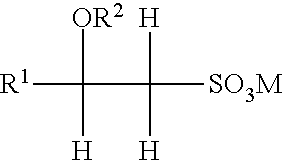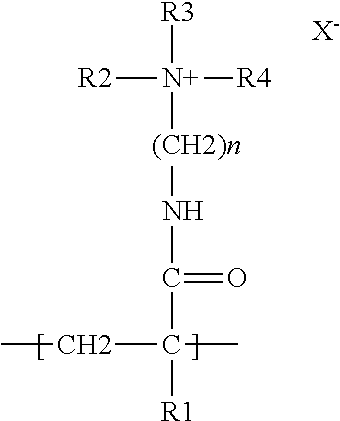Delivery particles
- Summary
- Abstract
- Description
- Claims
- Application Information
AI Technical Summary
Benefits of technology
Problems solved by technology
Method used
Image
Examples
example 1
[0293]
Oil7.5gramsAmine modified polyether acrylatePhase17.5gramsEthylene glycol dimethacrylate1.8gramsMonobutyl maleate223.7gramsPine oil3grams1-hydroxycyclohexyl phenyl ketoneWater300gramsDistilled waterPhase25gramsPolyacrylic acid10grams5% NaOH
[0294]Mix the oil phase and stir for 1 hour under a nitrogen blanket. Stir at 300 rpm. Add water phase and stir with magnetic stirrer. At the same time, expose to UV light for about three hours. Mill at 70° C. for 3 hours increasing speed to 400 rpm while continuing UV exposure. Use end of milling size of 12.4.
[0295]EXAMPLES 2-4 are general examples, providing a description of the process for making capsules with UV initiation in the wall pre-reaction, capsule curing, or both steps. Examples 5-7 provide specific examples corresponding to the general examples given in examples 2-4.
example 2
Thermal Pre-Reaction, UV-Cured Wall
[0296]The systems described are prepared with a core consisting of 2% I6B dye in soybean oil methyl ester, SR355 is the primary wall material, TBAEMA is the oil-soluble amine, and MBM is the oil-soluble acid. The oil solution contained Vazo-52 (thermally initiator) along with a photo initiator (in this case Ciba Irgacure 651 or Ciba Darocure 1173). The water phase contained another photo initiator (Ciba Darocure 1173). Batches are prepared in a glass, jacketed reactor, and a nitrogen blanket is applied at 300cc / min.
[0297]Oil containing the initiators is heated to 75° C., held at 75° C. for 30 minutes, cooled to 55° C. in 75 minutes. Additional wall material-containing oil solution is added, and the combined oils are held at 55° C. for another 30 minutes before addition of the water phase and the start of milling. After milling the emulsion is mixed for 45 minutes at 55° C. before the application of a UV lamp. The 200 Watt UV source is placed about ...
example 3
UV Pre-Reaction, UV-Cured Wall
[0299]The oil phase contained core material (2% I6B in ME-130 in this case), SR355, TBAEMA, MBM, and Irgacure 651 photo initiator. The level of photo initiator used is 20-80% of the level of thermal initiator typically employed. Half of the total oil-phase photo initiator is initially placed in the oil phase. The batch is prepared in a jacketed, glass reactor with application of a nitrogen blanket at 300cc / min. The oil is treated with a UV lamp for 5 minutes. After treatment the oil phase has generally become cloudy. The second-half of the oil phase photo initiator is added and allowed to dissolve. The water phase (with water phase initiator Darocure 1173) is added and milling begun. After milling the batch wall allowed to mix for 45 minutes before application of the UV lamp for 18 hours.
[0300]The mean particle size of the UV cured capsules is 13.93 μm.
PUM
| Property | Measurement | Unit |
|---|---|---|
| Fraction | aaaaa | aaaaa |
| Fraction | aaaaa | aaaaa |
| Fraction | aaaaa | aaaaa |
Abstract
Description
Claims
Application Information
 Login to View More
Login to View More - R&D
- Intellectual Property
- Life Sciences
- Materials
- Tech Scout
- Unparalleled Data Quality
- Higher Quality Content
- 60% Fewer Hallucinations
Browse by: Latest US Patents, China's latest patents, Technical Efficacy Thesaurus, Application Domain, Technology Topic, Popular Technical Reports.
© 2025 PatSnap. All rights reserved.Legal|Privacy policy|Modern Slavery Act Transparency Statement|Sitemap|About US| Contact US: help@patsnap.com



